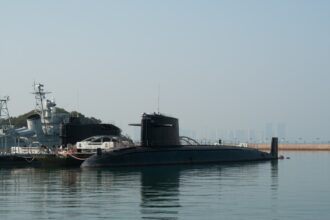Submarine acoustic quieting is a critical aspect of naval warfare and maritime operations, focusing on reducing the noise produced by submarines to enhance their stealth capabilities. The ability to operate undetected is paramount for submarines, as it allows them to gather intelligence, conduct surveillance, and engage in combat without revealing their position. The evolution of submarine technology has necessitated continuous advancements in acoustic quieting techniques, which have become increasingly sophisticated over the decades.
As nations invest in their naval capabilities, the quest for quieter submarines remains a top priority, influencing design choices and operational strategies. The significance of acoustic quieting extends beyond military applications; it also has implications for marine life and environmental conservation. The sounds generated by submarines can disrupt marine ecosystems, affecting the behavior and communication of various aquatic species.
Consequently, the development of quieter submarines not only enhances military effectiveness but also addresses environmental concerns, making it a multifaceted challenge that requires collaboration between engineers, scientists, and policymakers. As the world navigates the complexities of modern warfare and environmental stewardship, submarine acoustic quieting stands at the intersection of technology and ecology.
Key Takeaways
- Early methods of submarine noise reduction focused on simple solutions such as sound-absorbing materials and mufflers.
- World War II had a significant impact on submarine acoustic quieting, leading to the development of more advanced noise reduction techniques.
- The Cold War spurred advancements in submarine acoustic technology, including the use of quieter propulsion systems and improved hydrodynamics.
- Materials science played a crucial role in quieting submarine acoustics, with the development of specialized materials for sound insulation and absorption.
- The integration of computational modeling has revolutionized submarine acoustic quieting, allowing for more accurate predictions and efficient design of quieter submarines.
Early Methods of Submarine Noise Reduction
In the early days of submarine development, noise reduction techniques were rudimentary at best. The first submarines, primarily used during World War I, were constructed with limited understanding of acoustics and hydrodynamics. Early methods focused on simple mechanical solutions, such as soundproofing compartments with thick materials to dampen noise.
These initial attempts were often ineffective due to the inherent limitations of the technology available at the time. The engines and propulsion systems used in these submarines were loud and inefficient, contributing significantly to their acoustic signatures. As submarine technology progressed, engineers began to explore more innovative approaches to noise reduction.
The introduction of electric propulsion systems marked a significant turning point in submarine design. Electric motors operated much more quietly than their diesel counterparts, allowing submarines to reduce their acoustic footprint while submerged. This shift not only improved stealth capabilities but also extended operational ranges, enabling submarines to remain undetected for longer periods.
The combination of soundproofing techniques and advancements in propulsion laid the groundwork for future developments in submarine acoustic quieting.
The Impact of World War II on Submarine Acoustic Quieting

World War II was a pivotal moment in the evolution of submarine technology and acoustic quieting methods. The conflict underscored the importance of stealth in naval warfare, as submarines became essential tools for disrupting enemy supply lines and conducting reconnaissance missions. As a result, significant resources were allocated to research and development aimed at reducing submarine noise levels.
Engineers and scientists collaborated to identify the sources of noise within submarines, leading to a deeper understanding of how sound travels through water and how it can be mitigated. During this period, several innovative techniques emerged that would shape future submarine designs. The use of rubber coatings on hulls became popular as a means to absorb sound waves and reduce reverberation.
Additionally, advancements in hydrodynamic design helped minimize cavitation—a phenomenon that occurs when bubbles form around propellers due to pressure changes, creating loud noise. These developments not only improved the stealth capabilities of submarines but also influenced post-war designs, setting a new standard for acoustic quieting that would be built upon in subsequent decades.
Advancements in Submarine Acoustic Technology during the Cold War
| Advancements | Details |
|---|---|
| Sonar Technology | Development of passive and active sonar systems for detecting and tracking enemy submarines. |
| Noise Reduction | Efforts to reduce the acoustic signature of submarines to make them harder to detect. |
| Underwater Communication | Improvements in underwater communication systems for submarines to maintain contact with command centers. |
| Acoustic Countermeasures | Development of technologies to counter enemy acoustic detection and tracking systems. |
The Cold War era marked a significant leap forward in submarine acoustic technology, driven by the intense rivalry between superpowers and the need for advanced military capabilities. During this time, both the United States and the Soviet Union invested heavily in research aimed at enhancing submarine stealth. The introduction of nuclear-powered submarines revolutionized naval warfare by allowing vessels to operate at greater depths and for extended periods without surfacing.
This advancement necessitated further innovations in acoustic quieting to ensure that these powerful vessels could remain undetected. One notable development during this period was the refinement of sonar technology. Submarines began to incorporate advanced passive sonar systems capable of detecting enemy vessels while remaining silent themselves.
These systems relied on sophisticated algorithms and signal processing techniques to analyze underwater sounds, allowing submarines to gather intelligence without revealing their presence. Additionally, advancements in materials science led to the creation of specialized coatings and insulation that further reduced noise levels. The combination of these technological advancements solidified the role of submarines as formidable assets in naval strategy.
The Role of Materials Science in Quieting Submarine Acoustics
Materials science has played a crucial role in advancing submarine acoustic quieting technologies. The development of new materials has enabled engineers to create quieter submarines by addressing various sources of noise. For instance, specialized composites and polymers have been designed to absorb sound waves more effectively than traditional materials.
These innovations allow for the construction of hulls that minimize noise generation while maintaining structural integrity and performance. Furthermore, advancements in vibration-damping materials have contributed significantly to reducing noise levels within submarines. By incorporating these materials into critical components such as engines and propellers, engineers can mitigate vibrations that would otherwise translate into sound waves detectable by enemy sonar systems.
The ongoing research into nanomaterials and smart materials holds promise for future developments in submarine acoustic quieting, potentially leading to even quieter vessels capable of operating undetected in hostile environments.
The Development of Propulsion Systems for Quieter Submarines

The evolution of propulsion systems has been a key factor in enhancing submarine acoustic quieting capabilities. Traditional diesel-electric systems were often noisy due to mechanical components and exhaust emissions. However, the advent of nuclear propulsion transformed submarine design by providing a quieter alternative that eliminated the need for surface running and reduced reliance on noisy diesel engines.
Modern submarines now utilize advanced electric propulsion systems that are designed with noise reduction in mind. These systems often incorporate features such as advanced gear designs and noise-dampening mounts that minimize vibrations transmitted through the hull. Additionally, innovations such as pump-jet propulsion have emerged as alternatives to traditional propellers, offering quieter operation while maintaining high maneuverability.
As research continues into alternative energy sources and propulsion technologies, the potential for even quieter submarines remains an exciting prospect for future naval operations.
The Influence of Hydrodynamics on Submarine Acoustic Quieting
Hydrodynamics plays a vital role in submarine acoustic quieting by influencing how water flows around a vessel and how sound propagates through it.
Engineers have invested considerable effort into optimizing hull designs to minimize cavitation and other noise-generating phenomena.
Computational fluid dynamics (CFD) simulations have become invaluable tools for understanding hydrodynamic behavior and its impact on acoustic signatures. By modeling water flow around various hull shapes and configurations, engineers can identify design features that enhance stealth while maintaining performance characteristics such as speed and maneuverability. As computational power continues to grow, so too does the ability to refine hydrodynamic designs further, paving the way for next-generation submarines with unprecedented levels of acoustic quieting.
The Integration of Computational Modeling in Submarine Acoustic Quieting
The integration of computational modeling has revolutionized the field of submarine acoustic quieting by enabling engineers to simulate complex interactions between sound waves, materials, and hydrodynamic forces. Advanced modeling techniques allow for detailed analysis of how different design choices impact a submarine’s acoustic signature before physical prototypes are built. This capability not only accelerates the design process but also reduces costs associated with trial-and-error testing.
One significant application of computational modeling is in predicting how changes in hull shape or material composition will affect noise generation during various operational scenarios. By simulating different conditions—such as varying depths or speeds—engineers can optimize designs for specific missions while ensuring that stealth remains a priority. As computational modeling continues to evolve with advancements in artificial intelligence and machine learning, its role in submarine acoustic quieting will likely expand further, leading to even more innovative solutions.
Innovations in Passive and Active Sonar Systems for Submarines
Sonar technology has undergone remarkable advancements over the years, significantly enhancing both passive and active systems used by submarines for detection and navigation purposes. Passive sonar systems are designed to listen for sounds generated by other vessels or underwater activities without emitting any signals themselves. Innovations in hydrophone technology have improved sensitivity and frequency range, allowing submarines to detect distant sounds while remaining undetected.
Active sonar systems, on the other hand, emit sound waves and analyze their echoes to identify objects underwater. While traditionally considered noisier than passive systems, recent innovations have led to quieter active sonar technologies that minimize their acoustic footprint during operation. These advancements enable submarines to gather critical intelligence while maintaining stealth capabilities.
The ongoing development of sonar technologies continues to play a crucial role in enhancing situational awareness for submarines operating in contested environments.
Environmental and Regulatory Factors in Submarine Acoustic Quieting
As concerns about marine ecosystems grow, environmental regulations increasingly influence submarine design and operation practices related to acoustic quieting. The sounds produced by submarines can disrupt marine life, particularly species that rely on echolocation or communication through sound waves. Consequently, navies around the world are under pressure to develop quieter vessels that minimize their impact on marine environments.
Regulatory frameworks are evolving to address these concerns, prompting naval forces to adopt more sustainable practices in submarine operations. This includes investing in research aimed at understanding how submarine noise affects marine ecosystems and implementing measures to mitigate these impacts during training exercises or deployments. By prioritizing environmental considerations alongside military objectives, navies can work towards achieving a balance between operational effectiveness and ecological responsibility.
Future Trends in Submarine Acoustic Quieting Technology
Looking ahead, several trends are poised to shape the future of submarine acoustic quieting technology. One significant area of focus is the continued development of advanced materials that offer enhanced sound absorption properties while remaining lightweight and durable. Innovations such as metamaterials—engineered materials designed to manipulate sound waves—hold promise for creating even quieter submarines capable of evading detection.
Additionally, advancements in artificial intelligence (AI) are expected to play a transformative role in submarine operations, including acoustic quieting efforts. AI algorithms can analyze vast amounts of data from sonar systems more efficiently than human operators, enabling real-time decision-making based on changing underwater conditions or threats. This capability could enhance situational awareness while allowing submarines to maintain stealth during complex missions.
As geopolitical tensions persist and technological competition intensifies among nations, the race for quieter submarines will continue unabated. The integration of cutting-edge technologies—ranging from advanced propulsion systems to innovative sonar solutions—will define the next generation of underwater warfare capabilities while ensuring that environmental considerations remain at the forefront of naval strategy.
The history of submarine acoustic quieting is a fascinating journey that highlights the technological advancements made to enhance stealth capabilities in naval warfare. This evolution has been crucial in maintaining the strategic advantage of submarines by reducing their acoustic signatures and making them less detectable by enemy sonar.




